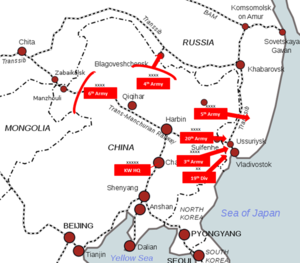
Back Кантокуен Bulgarian Kantokuen Spanish کانتوکوئن Persian Kantokuen ID 関東軍特種演習 Japanese План «Кантокуэн» Russian 關東軍特種演習 Chinese
| Kantokuen | |
|---|---|
| Part of Pacific War of World War II | |
 A map outlining the initial Japanese offensive moves against the Soviet Union, with final objective being a line that ran along the western slope of the Greater Khingan Range | |
| Operational scope | Strategic |
| Location | |
| Planned | September 1941[1] |
| Planned by | Japanese Imperial General Headquarters |
| Objective | Occupation of the Far East of the Soviet Union |
| Outcome | Canceled on August 9, 1941 |
Kantokuen (Japanese: 関特演, from 関東軍特種演習, Kantōgun Tokushu Enshū, "Kwantung Army Special Maneuvers"[2]) was an operational plan created by the General Staff of the Imperial Japanese Army for an invasion and occupation of the Russian Far East, capitalizing on the outbreak of the Soviet–German War in June 1941. Involving seven Japanese armies and a major portion of the empire's naval and air forces, it would have been the largest combined arms operation in Japanese history up to that point, and one of the largest of all time.[3]
The plan was approved in part by Emperor Hirohito on July 7 and involved a three-step readiness phase followed by a three-phase offensive to isolate and destroy the Soviet defenders within six months.[4] After growing conflict with simultaneous preparations for an offensive in Southeast Asia, together with the demands of the Second Sino-Japanese War and dimming prospects for a swift German victory in Europe, Kantokuen fell out of favor at Imperial General Headquarters and was eventually abandoned after increased economic sanctions by the United States and its allies.[5]
Nevertheless, the presence of large Japanese forces in Manchuria forced the Soviets, who had long anticipated an attack from that direction, to retain considerable military resources in Siberia throughout World War II.[6]
© MMXXIII Rich X Search. We shall prevail. All rights reserved. Rich X Search